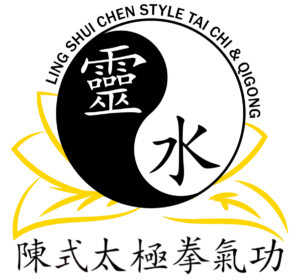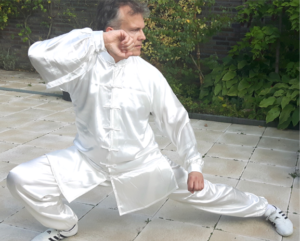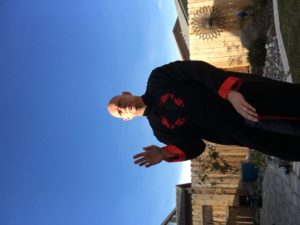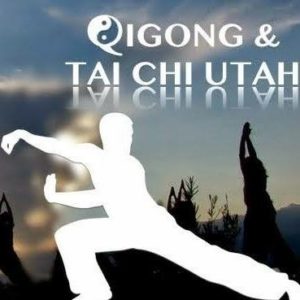Slanted FlyingJournal of Tai Chi Chuan
Training
Fangsong (放松) and Peng (掤) in Taijiquan
In the practice of Taijiquan (太極拳), we strive to properly balance the yin (阴) and yang (阳) principles such that there is no excess and no deficiency, no protrusions and no depressions, no resisting but also no collapsing. Fangsong (放松 release or let go + loose = “relax”) and peng (掤 outward supportive structure, or “muscle tonus”) are terms/principles that Taijiquan uses to address these dualities.
There are two common ways that the term peng is used. One is the structural energy that fills out the shape of our body, and the other is the energy applied as one of the thirteen energies/techniques (十三式 shi san shi) of Taijiquan, and which is often translated as “warding off” or “rebounding” energy.
This article uses the general structural principle for peng; it is like the air that fills a properly inflated rubber ball and gives it the resilient structure allowing the peng application to bounce away incoming forces.
While there are numerous articles about fangsong, few tie this concept together with peng; but fangsong is the yin to peng’s yang. We strive to have both, and to train our bodies in a manner that they are complementary, not contradictory.
For examples of writings on fangsong (frequently shortened to just song), see the following:
http://www.egreenway.com/taichichuan/relax1.htm
It makes sense to emphasize fangsong first because most beginning practitioners start out being too stiff or rigid. Most intermediate and even advanced practitioners can still improve their fangsong. But this is also true for peng. Most practitioners can improve their structures such that the “nine pearl bends” (九曲珠 jiu qu zhu) are aligned with force/energy transmitted through stabile centers.
One way to view the nine pearl bends is to think of nine pearls on a string. If they are all touching and all of their centers align, then force that is applied to the first pearl can easily be transmitted all the way to the last pearl. But if the centers are not aligned, then the force will cause a bend to occur. The force would then “leak” out to the side.
In our bodies, if forces are transmitted through the centers of our joints (our “pearl bends”), then that force can be efficiently transmitted, without “leakage” to the sides which would require tensing muscles (or locking the structure) in order to hold the joints in place.
The better aligned our skeletal structure is, the less we need to use muscles to resist deformation of our structure. Holding the structure in alignment, for receiving or transmitting forces without “leakage”, allows for greater relaxation. Relaxation depends on good structure, and a good structure is one that aligns and, therefore, can be relaxed.
In the following video of a Newton’s Cradle toy, all of the balls’ centers align and allow force to be transmitted through them to the other balls. But at ~1:38-1:41 the balls’ centers are misaligned since they were wiggling too much when started, resulting in force “leaking” out the side and disrupting the transmission of force.
In Taijiquan we want an aligned and “full” structure (peng) rather than a collapsed or limp structure. We want a resilient structure that continuously balances yin and yang whether we are issuing or receiving forces.
Since we are structurally dynamic, unlike a pearl, our movements can result in the energy moving around our joints rather than through the centers, but this should still balance yin with yang in a manner similar to the rotation of a toy top where the spinning stabilizes the top. This motion is easy to illustrate by rotating the hips while keeping the center of the body (the spine) stable and centered. We can maintain “central equilibrium” (中定 zhongding) while rotating around parts of our body, including individual joints.
Another way one can look at this is to recognize that all joints have extensor and flexor muscles that move them. These complementary sets of muscles work on opposing sides of the joints and can therefore be used to stabilize the center of the affected joint. But rather than producing isometric tension that locks a joint in one rigid position, we can instead use these opposing muscles in a dynamic spiraling way that stabilizes the joint without locking it.














Dear Mr Pasek,
I’m a Taijiquan practitioner based in Montenegro, where I’m doing my best to get people to discover this wonderful art.
I hope you don’t mind my contacting you via your blog but I do not have your e-mail address.
Currently, the role of the spine when doing Taiji is of particular importance to me, especially the issue of to tuck or not to tuck in the tailbone.
I’ve just discovered the thread devoted to this issue on the YFTC discussion board and your contributions to the discussion in 2013. I find a lot of the posts really interesting, although unfortunately many refer to drawings / illustrations that I cannot see anywhere.
I’m aware it was a long time ago, but could you by any chance let me know how I could get access to those illustrations?
I’m currently reading Mary Bond’s “New Rules of Posture”, which triggered a process of reflection on tucking:
“To become aware of your outer corset, lie on your back and contract your abdominal muscles in a way that flattens your back to the floor and draws your lower ribs down and together in front. Notice how this action restricts your breathing.
Make the same abdominal contraction while standing up. The action will tuck your tail under and compress your chest. Walk around while maintaining outer corset tension and notice how it blocks freedom of movement in your whole body. You can’t breathe freely, and with your pelvis tucked under, you can’t freely move your legs.” (p. 95)
Many thanks in advance.
Season’s Greetings,
John Rogers
The following relates to my article, and so I am posting it here.
A translation of a Yang Zhendo instructional video gave the following:
“Today there are many practitioners of Yang style Taijiquan, and unfortunately many have not fully comprehended the meaning of fang song, and they misinterpret its meaning. This is because song (relax or loosen) and ruan (soft) were put into the same category. Many think that song is ruan. What we consider as song is not ruan. Song requires that the joints and the muscles be intentionally letting loose, and extended.”
And: “Everyone should comprehend fully the meaning of fang song, let loose, in practice. One should be loose and extended, not loose and soft.”
When you use jin/intent, you are accessing involuntary-muscular functions of the body normally controlled by the subconscious. For example, if I “will” a jin-path from my feet to my shoulder, that path is arranged by the involuntary muscle system and to attempt to do it through the voluntary/primary muscular system would be counter-productive. Therefore you need fangsong for that element.
In order to re-coordinate the body to move with the involuntary-muscles and attendant fascia-pulling (with the dantian as the main control nexus), I have to relinquish the patterning of “normal movement” and learn/adopt a different way of moving. I need to relax my impulses to move with my long-trained “normal movement” and slowly re-pattern to move via the dantian. You need fangsong for that reason, also.
“Extended” is needed so that the tissues connect from fingertips to toes. If the toes and fingertips are connected to the dantian, the dantian can’t control them.
Thanks for commenting Mike. I know that you think deeply about TJQ and have many insights from your studies and contemplations.
There is so much about the mental aspects of this art that are important, but I am not sufficiently knowledgeable about it to be able to address many topics authoritatively. There are many aspects of the mind that I do not think that scientists even understand. “Intent” gets into that poorly understood realm, although I definitely think that there are things going on there that would be difficult to analyze and explain using current knowledge. The “placebo effect” (a product of one’s thoughts/attitudes) is widely recognized, and can have such profound effects that scientists are practically required to control for this in their experimental designs using human subjects. For example, it has been shown that if you give someone a genetic test and tell them that the results indicate that they have a genetic predisposition for poor health, then the person is likely to have measurable changes in their physiology that conform more to their mental image and actually make them less healthy! Can using “intent” during TJQ practice change a practitioner’s physiology? I think that it is likely, but I am not certain that I could adequately explain it.
So “intent” is likely to be very important, but how to explain it? Anyway – practice with “intent” and think healthy and happy thoughts!